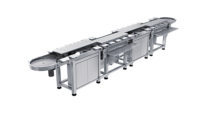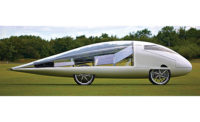Cars have become rolling computers today, with numerous electronic controls incorporated into their design. With the interconnectivity and functionality designed into the small space of the driver’s console, OEMs must ensure that one bad component doesn’t spoil an otherwise quality product. Unfortunately, we have seen enough product recalls in the past few years to know how costly that can be to the automotive industry.
That’s why companies like Methode Electronics have become such important partners in the automotive supply chain. They’re building their success on testing the quality of their components.
Among other products, Methode designs and manufactures the integrated center stack (ICS) for vehicle interiors. These consoles contain all the electronic bells and whistles of modern automobiles: navigation display, touchscreen functionality, radio controls, HVAC controls and vehicle communications. It used to be that these bells and whistles were all separate components. Today, consumers demand a more integrated, dense design in one assembly.
To ensure product quality, Methode conducts numerous tests on ICS modules, including electromagnetic compatibility (EMC) testing and qualification. Methode worked with Parker Hannifin to develop a flexible pneumatic test system to actuate the various buttons, knobs and other control interfaces on the ICS module. Each test must be set up independently to actuate the various interfaces in a specific sequence and a specific number of cycles.
Why are pneumatic components key to these test systems? “Any time you send current down a wire, you have the potential for emitting electromagnetic interference off that wire,” explains Steven Heinrich, chief engineer for Methode Electronics. “On an ICS, we have to press a series of anywhere from six to 19 buttons, and turn two to three knobs while the module is on and while it’s being tested. This has to be done without any conductive surfaces involved, or any other electrically energized product turning those things—otherwise the electromagnetic radiation from the actuators could interfere with the test.”
The system consists of 32 actuators, each of which runs independently. Some are single-acting, while others are double-acting. The latter allows engineers to carefully control both the extend and retract motions of the actuator.
Although the test chamber has a fixed design, the test controller had to be flexible so the system could be used with various ICS designs or be relocated to another test chamber in another assembly plant. With input from Methode, Parker customized its BL67 controller specifically for the ICS testing application. What was needed from the onset was a software-based tester that could develop and grow as more products needed to be tested.
Before, Methode would go to an outside EMC house certified by the OEM to have ICS actuation equipment designed and built. This approach was not financially sustainable, however, since it relied on the vendor to build unique fixtures and assemblies for actuation in EMC chambers. These vendors had long development cycles, driven in part by the need to learn the operation of the product and the specific testing requirements.
“At Methode, we know where the customer’s product portfolio is going because we’re designing it, and we have our own business road map,” says Heinrich. “More importantly, we’re a global company with design centers and test facilities around the globe. By developing a solution in-house, we are saving costs and developing a more flexible design that can be used again in the future. We can build these units and ship them to our other design centers when we co-design globally. That means we all have the same equipment, which is paramount when you do distributed designs globally.”
How It Works
There are four categories of EMC testing:
Conducted emissions testing looks for emissions produced within the electronics that feed back out through the power supply, like to the battery on a vehicle.
Conducted immunity testing looks for electronic “noise” from the vehicle’s wire harness—such as inductive loads caused by a faulty alternator or fuel pump—that gets fed back into the ICS module.
Radiated emissions testing measures how much electromagnetic interference (EMI) the product emits.
Radiated immunity testing bombards the ICS with EMI—such as from a nearby walkie-talkie, cell phone or radar—to ensure that the product continues to operate correctly.
Because Methode has global laboratories with global customers, the goal is to copy various test environments exactly. The challenge with EMC testing is that one little difference in a test setup could result in different EMC results. The best way to control that is to use common equipment globally, with the modularity and expandability to grow with the product portfolio.
Methode now uses two Parker BL67 controllers that can be reconfigured via open-source software to store all testing programs for the parts to be tested. Each can run 32 actuators independently. These fieldbus systems are supported by the major PLC manufacturers and have three basic components:
Communication modules providing an interface between the PLC and fieldbus.
Valve driver modules providing control for 32 solenoids.
24 VDC digital I/O and analog I/O modules connecting discrete field devices and the PLC.
In the Methode application, every module has a series of buttons and knobs that are pressed and turned to show radiated emissions. The engineers doing the testing do not have to deal with wiring. They simply plug and play, which cuts down on setup time.
“We take modularity very seriously here,” Heinrich says. “When you come up with designs, whether product or test designs, if you do it modularly with common equipment, it saves re-test costs.”
Once a new ICS design is production-ready, the pneumatic test system puts it through its paces to validate that the design meets requirements. If the prototype passes, Methode does a preproduction build of the design and reruns the test.
“We re-do those tests to confirm that nothing has been disturbed by the production process that would affect the design,” Heinrich explains.
Tried and True—but Verify
In this age of modular electronics and tried-and-true design, is such rigorous testing necessary?
“Although from a design level, we believe in modularity and reuse, there are always certain aspects of the design that are unique or new that require us to test,” Heinrich answers. “We’re not inventing everything from ground zero all the time. A manifold can be used over and over and over for an endless possibility of different products, just by changing the way the software is running or adding another module to the software.”
“We’re able to use Parker’s mobile control panel through endless amounts of testing,” Heinrich continues. “We can make it test whatever we want, meaning we don’t have to keep buying new fixtures and actuator control systems every time we need to test a different product. As a result, we’ve met deadlines that we otherwise wouldn’t have met.”






